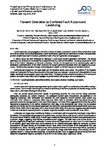Tsunami Generation by Combined Fault Rupture and Landsliding
| dc.contributor.author | Perez del Postigo Prieto, Natalia | |
| dc.contributor.author | Raby, Alison | |
| dc.contributor.author | Boulton, Sarah | |
| dc.contributor.author | Whittaker, C | |
| dc.date.accessioned | 2019-04-04T07:38:45Z | |
| dc.date.available | 2019-04-04T07:38:45Z | |
| dc.date.issued | 2018 | |
| dc.identifier.uri | http://hdl.handle.net/10026.1/13604 | |
| dc.description.abstract |
Tsunami generation and propagation mechanisms should be clearly understood in order to inform predictive models and improve coastal community preparedness. Experimental results, supported by mathematical models, could potentially provide valuable input data for standard predictive models of tsunami generation and propagation. A unique set-up has been developed to reproduce a dual-source tsunami generation mechanism. The test-rig replicates a two-dimensional underwater fault rupture followed by a submarine landslide. The set-up was placed in a 20m flume of the COAST laboratory at Plymouth University. The aim of the experiments is to provide quality data for developing a parametrization of the initial conditions for tsunami generation processes which are triggered by a dual-source. The free surface elevation changes are investigated in relation to the fault rupture and landslide motions. During the test programme, the water depth and the landslide density were varied. The position of the landslide model was tracked and the free surface elevation of the water body was measured. Hence tsunami characteristics of wave height, wavelength and propagation speed were determined. This paper provides a detailed description of the test rig and presents some preliminary results which highlight the performance of the test rig in terms of repeatability. | |
| dc.language.iso | en | |
| dc.subject | Tsunami generation | |
| dc.subject | Submarine landslide | |
| dc.subject | Fault rupture | |
| dc.subject | Physical modelling | |
| dc.subject | Dual-source | |
| dc.title | Tsunami Generation by Combined Fault Rupture and Landsliding | |
| dc.type | conference | |
| dc.type | inproceedings | |
| plymouth.date-start | 2018-05-22 | |
| plymouth.date-finish | 2018-05-26 | |
| plymouth.conference-name | COASTLAB 2018 | |
| plymouth.organisational-group | /Plymouth | |
| plymouth.organisational-group | /Plymouth/Admin Group - REF | |
| plymouth.organisational-group | /Plymouth/Admin Group - REF/REF Admin Group - FoSE | |
| plymouth.organisational-group | /Plymouth/Faculty of Science and Engineering | |
| plymouth.organisational-group | /Plymouth/Faculty of Science and Engineering/School of Engineering, Computing and Mathematics | |
| plymouth.organisational-group | /Plymouth/Faculty of Science and Engineering/School of Geography, Earth and Environmental Sciences | |
| plymouth.organisational-group | /Plymouth/REF 2021 Researchers by UoA | |
| plymouth.organisational-group | /Plymouth/REF 2021 Researchers by UoA/UoA07 Earth Systems and Environmental Sciences | |
| plymouth.organisational-group | /Plymouth/REF 2021 Researchers by UoA/UoA12 Engineering | |
| plymouth.organisational-group | /Plymouth/Users by role | |
| plymouth.organisational-group | /Plymouth/Users by role/Academics | |
| plymouth.organisational-group | /Plymouth/Users by role/Researchers in ResearchFish submission | |
| dc.publisher.place | Santander | |
| dcterms.dateAccepted | 2018-01-01 | |
| dc.rights.embargoperiod | Not known | |
| rioxxterms.licenseref.uri | http://www.rioxx.net/licenses/all-rights-reserved | |
| rioxxterms.type | Conference Paper/Proceeding/Abstract |


